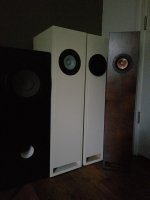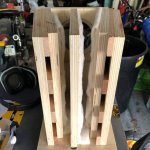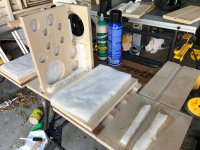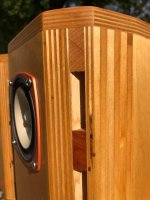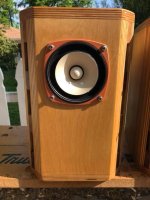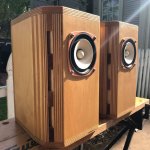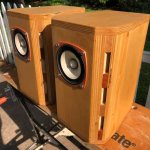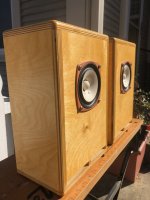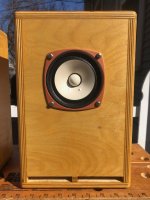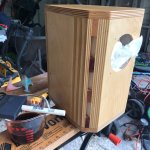Not another Pensil
Made another Pensil, I must be addicted, yes definitely! The one on the far right CHR-70.3 with my unique staining attempt, so ugly I'm starting to really like it, . So the sound, well just incredible. Not as forward as the CHN-70 and the detail is phenomenal. The 10p's are in a totally different class on their own, really love them all. So what's next? I have a pair of Alpair 10M.3 looking for a home, no room for the Pensil so maybe a GRMar-ken ??? (and then the Pensil later
. So the sound, well just incredible. Not as forward as the CHN-70 and the detail is phenomenal. The 10p's are in a totally different class on their own, really love them all. So what's next? I have a pair of Alpair 10M.3 looking for a home, no room for the Pensil so maybe a GRMar-ken ??? (and then the Pensil later  )
)
Made another Pensil, I must be addicted, yes definitely! The one on the far right CHR-70.3 with my unique staining attempt, so ugly I'm starting to really like it,
Attachments
Last edited:
Diatone P610mb 50th anniversary.



An externally hosted image should be here but it was not working when we last tested it.
An externally hosted image should be here but it was not working when we last tested it.
An externally hosted image should be here but it was not working when we last tested it.
An externally hosted image should be here but it was not working when we last tested it.
amp is a bit overkill at 150wpcyours are really beautiful as well and excellent drivers you have there!Excellent style!
those are amazing! a friend used to own a pair. and the quality of the bass is something i ididn't anticipate.
Made another Pensil, I must be addicted, yes definitely! The one on the far right CHR-70.3 with my unique staining attempt, so ugly I'm starting to really like it,. So the sound, well just incredible. Not as forward as the CHN-70 and the detail is phenomenal. The 10p's are in a totally different class on their own, really love them all. So what's next? I have a pair of Alpair 10M.3 looking for a home, no room for the Pensil so maybe a GRMar-ken ??? (and then the Pensil later
)
Thanks

Thanks for the kind words as I'm not nearly in your league for beautiful speaker builds. Yes these Pensil designs are incredible for how much one can get out of such a small driver. I would really like to know more details about the vintage drivers you have...those are amazing! a friend used to own a pair. and the quality of the bass is something i ididn't anticipate.
Thanks

This hobby is truly addicting, thanks for your response and the music is flowing big time...Mancave62, enio nery,
Congratulations to you both on your builds. Have a great weekend and enjoy the music!
I recently built two of Planet 10's mFonken designs for Fostex FE103Sol: the Classic Golden Ratio and the trapezoidal.
The CGRs are finished with Watco Golden Oak Danish oil and satin polyurethane (hey, golden for golden -- why not?).
The traps are finished with six coats of Trader Joe's French Roast and two coats of satin polyurethane. Back around New Year's, my wife's cousin was telling me about using coffee as a natural wood stain. The colors of the material selected for this build -- Baltic Birch, white oak, Brazilian cherry -- reminded me of coffee. So I tried some of my afternoon fix on scrap and liked the result... et voilà. I'd been planning to veneer them with cherry and finish with natural Danish oil but decided to respect the original material.
The CGRs are finished with Watco Golden Oak Danish oil and satin polyurethane (hey, golden for golden -- why not?).
The traps are finished with six coats of Trader Joe's French Roast and two coats of satin polyurethane. Back around New Year's, my wife's cousin was telling me about using coffee as a natural wood stain. The colors of the material selected for this build -- Baltic Birch, white oak, Brazilian cherry -- reminded me of coffee. So I tried some of my afternoon fix on scrap and liked the result... et voilà. I'd been planning to veneer them with cherry and finish with natural Danish oil but decided to respect the original material.
Attachments
Last edited:
Wow! I love Trader Joe’s coffee and would love to do this on one of my projects. I’d have thought the French Roast would look darker but it’s still beautiful. Thanks for sharing.
Btw, would the tuning on these boxes be considered aperiodic or something else?
Thanks! This was a very rewarding pair of builds. And both sound SUPERB.
Dave Dlugos describes them as "near aperiodic" -- Meet the Fonkens.
While doing research I found two general ways of making a stain from coffee. One was to mix the grounds with vinegar, put them in a jar with some steel wool, and let them brew over night. That seemed to result in a really dark, concentrated stain with deep penetration.
The other was to use regularly (or strongly) brewed coffee or instant coffee, let it fully cool, and then apply in coats (they dry very quickly) until the color is to your liking.
I had in mind more of a light, filmy finish, so I went with regular brewed coffee. Literally, I made my afternoon coffee like normal but with an extra two cups. I applied the six coats with a foam brush while I worked and did other things throughout the day. Nearly all of the two cups got used.
Also, in my experience, birch absorbs oil-based stains and oils unevenly. Using a pre-stain wood conditioner helps a lot, but you can tell that birch doesn't really like to take color from oils. Coffee is essentially a water-based stain (OK, there's caffol in it, but it's more water than oil) and it absorbs perfectly evenly with no pre-conditioning.
Attachments
Last edited:
While doing research I found two general ways of making a stain from coffee. One was to mix the grounds with vinegar, put them in a jar with some steel wool, and let them brew over night. That seemed to result in a really dark, concentrated stain with deep penetration.
The vinegar/steel wool combination you describe (minus the coffee grounds) was named “liquid nightmare” by George Frank in his book “Classic Wood Finishing” for good reason. If any of you decide to try this make sure you do NOT seal the jar tightly with a screw top lid. This stuff needs to breathe; otherwise, you will have an exploded jar of dye everywhere if left sealed long enough. You will get the best results by filling a jar halfway with scrap iron or rusty nails and then covering them with vinegar (I use white vinegar). Add some logwood extract (or the coffee grounds) and let sit for a week or two. Strain it into another jar and you will have an excellent dark brown to black dye.
I recently built two of Planet 10's mFonken designs for Fostex FE103Sol: the Classic Golden Ratio and the trapezoidal.
The CGRs are finished with Watco Golden Oak Danish oil and satin polyurethane (hey, golden for golden -- why not?).
The traps are finished with six coats of Trader Joe's French Roast and two coats of satin polyurethane. Back around New Year's, my wife's cousin was telling me about using coffee as a natural wood stain. The colors of the material selected for this build -- Baltic Birch, white oak, Brazilian cherry -- reminded me of coffee. So I tried some of my afternoon fix on scrap and liked the result... et voilà. I'd been planning to veneer them with cherry and finish with natural Danish oil but decided to respect the original material.
Very impressive build congrats, I used the same baltic birch 24mm for my last build and with no experience on treat the wood I make different try with different oil and stain but I did not like the result, so I decide to respect the natural colour and simply use Konig polyurethane, but the idea of using coffee is really good and the result, woww love it, thanks for sharing this I will for sure try it next time.....all the best and enjoy the music
just regular bass reflex. i have an onken and i designed it in winisd.
Wow! I love Trader Joe’s coffee and would love to do this on one of my projects. I’d have thought the French Roast would look darker but it’s still beautiful. Thanks for sharing.
Btw, would the tuning on these boxes be considered aperiodic or something else?
beautiful looking speakers!!! congrats on the build!
I recently built two of Planet 10's mFonken designs for Fostex FE103Sol: the Classic Golden Ratio and the trapezoidal.
The CGRs are finished with Watco Golden Oak Danish oil and satin polyurethane (hey, golden for golden -- why not?).
The traps are finished with six coats of Trader Joe's French Roast and two coats of satin polyurethane. Back around New Year's, my wife's cousin was telling me about using coffee as a natural wood stain. The colors of the material selected for this build -- Baltic Birch, white oak, Brazilian cherry -- reminded me of coffee. So I tried some of my afternoon fix on scrap and liked the result... et voilà. I'd been planning to veneer them with cherry and finish with natural Danish oil but decided to respect the original material.
thanks alot! listening to music is more satisfying when your gears are DIY. have a good day!
Mancave62, enio nery,
Congratulations to you both on your builds. Have a great weekend and enjoy the music!
thanks alot! they look much better in picture than in person ahahaha
they are Diatones P610MB. the most intimate, engaging and smoothest sounding full range speakers i've ever had or heard. thanks for your interest! enjoy the music!
they are Diatones P610MB. the most intimate, engaging and smoothest sounding full range speakers i've ever had or heard. thanks for your interest! enjoy the music!
Thanks for the kind words as I'm not nearly in your league for beautiful speaker builds. Yes these Pensil designs are incredible for how much one can get out of such a small driver. I would really like to know more details about the vintage drivers you have...
Member
Joined 2009
Paid Member
Anybody tried the cloned drivers ?
2 unit davidlouis audio 6.5inch DIATONE P610MK3 2018Version | eBay
2 unit davidlouis audio 6.5inch DIATONE P610MK3 2018Version | eBay
i just ordered a pair out of curiosity.(Ferrite version) let's see if they really are the upgraded version of the original.
Anybody tried the cloned drivers ?
2 unit davidlouis audio 6.5inch DIATONE P610MK3 2018Version | eBay
- Home
- Loudspeakers
- Full Range
- Full Range Speaker Photo Gallery
